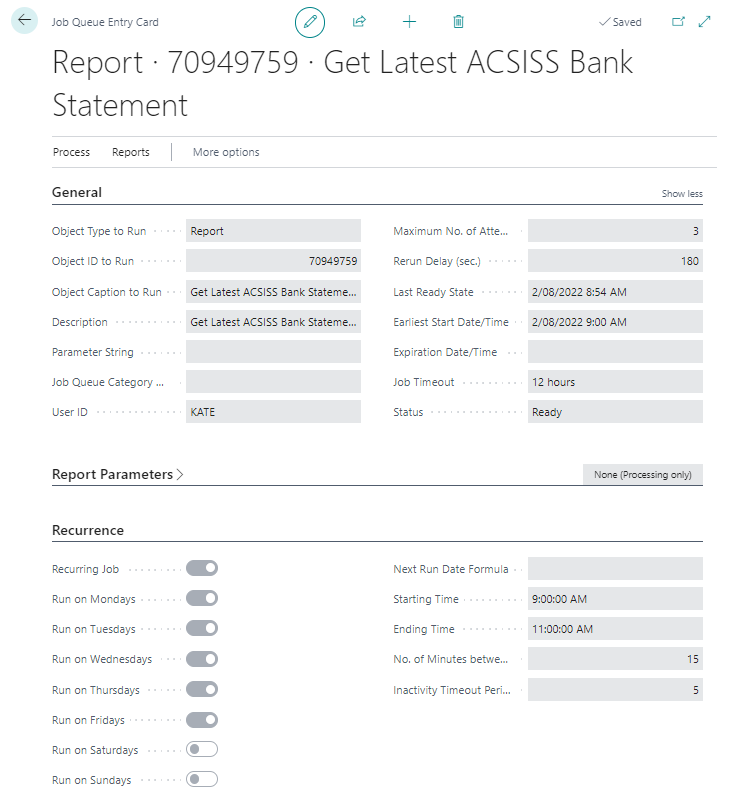5. Schedule your Transaction Imports using the Job Queue
Microsoft Business Central has the function to schedule jobs and this includes the ability to schedule the collection of bank transactions from the ACSISS service. The ACSISS connect app adds a report object to the business central environment during installation with the following details
Object ID: 70949759
Object Name: Get Latest ACSISS Bank Statement
Users can review, edit, or add to this schedule by utilising the Job Queue list. This can be found by utilising the search function as shown below.
Users must have the correct privileges to view and edit the job queue.

Instructions
From BC, go to search and type in “job queue” > Go to Job Queue Entries
Add a job to collect bank transactions by clicking New
Complete the Job Queue Entry Card as follows:
General Section
Object Type = Report
Object ID = 70949759 – this can be typed or selected from the list of jobs
Description = this will be prefilled with ‘Get Latest ACSISS Bank Statement’ however it can be modified with a custom name if required. This is recommended if this job is added to the list multiple times to distinguish the purpose.
Maximum Number of Attempts = 3. In the unlikely event of the ACSISS service being unavailable the scheduled job will attempt to run x times before stopping. This can be set to your desired number however remembering the download will be scheduled to connect per the No. of Minutes between runs, therefore setting to a high number will only create a heavy burden on both the Microsoft & ACSISS services.
ReRun Delay in seconds = 180 (3 minutes) in the unlikely event the ACSISS services is offline this is the amount of time the Job Queue will wait between re-runs. It is recommended to keep this low 60 - 180, and like the setting above be in the context of understanding the Job Queue will be scheduled to run regularly.
Earliest Start date: this can be used should you wish to delay the first data collection. This determines the date & time the job will first run, leave this blank (or select a past date) for the job to commence immediately
Recurrence section
Recurrence = select the required days, Monday to Friday (data is not made available over the weekends)
Starting time: we recommend any time after 9:00 am** AEDT. ACSISS generally makes data available between 8:30 am and 9:00 am AEDT (we are based in Sydney). To allow us to manage any minor delays, starting the data collection at 9am will ensure successful data delivery. Please also note this time is local to your time zone therefore if you are not set to AEDT you should adjust accordingly. For example, customers in Perth could have this set to 7am
Ending time: we recommend setting this 1.5 to 2.5 hours after the time selected above**. The ending time is the point the Job Queue stops collecting data for the day
Number of minutes between runs: This is the number of minutes the job queue will wait to collect data from the ACSISS service between the start and end time set above (for example if start is 9, then the job will collect at 9:00, 9:15, 9:30, 9:45, etc. We recommend setting this no lower than 15 minutes. SISS does monitor connections to its service, should we notice a customer connecting at an unreasonable frequency we will ask for you to review these settings.

Completed job queue entry card
(**) For customers who have multiple companies within Business Central, it should be noted that each company will connect and collect transactions separately. This will result in multiple connections to the ACSISS service. We advise system administrators consider a staggered approach to data collection. The ACSISS REST API does limit the number of calls to 1 CPS (call per second) for each of our clients, this may impact users who have many companies in Business Central. To illustrate the issue; should you have 10 companies attempting to all collect data at say 9:00 am, Business Central is likely start collecting all companies at precisely 9 am, at some point one connection will exceed the 1 CPS threshold. To improve your level of successful data collection we recommend a staggered approach as shown below.
connection will exceed the 1 CPS threshold. To improve your level of successful data collection we recommend a staggered approach.
As an example:
C1 start time 9:00, end time 11:10, time between runs 15
C2 start time 9:01, end time 11:11, time between runs 15
C3 start time 9:02, end time 11:12, time between runs 15
C4 start time 9:03, end time 11:13, time between runs 15
C5 start time 9:04, end time 11:13, time between runs 15
C6 start time 9:05, end time 11:13, time between runs 15
C7 start time 10:00, end time 13:10, time between runs 15
C8 start time 10:01, end time 13:11, time between runs 15
C9 start time 11:00, end time 14:10, time between runs 15
C10 start time 13:00, end time 16:10, time between runs 15
Companies 1-6 maybe the primary operating business requiring timely reconciliations, therefore their bank data is collected first while companies 7-9 are collected a little later. Company 10 does not generally require daily attention therefore its data collection is pushed towards the end of day.After adding the Job to the list by default the job will be set to “on hold”, i.e. the job is on hold and not operational. The status must be set to “Ready” to ensure it is operational.
Go to Actions > Job Queue > Set Status to Ready
You are now ready to import to the PRJ or BAR
